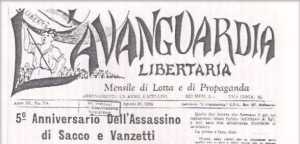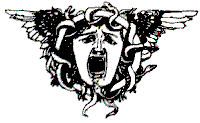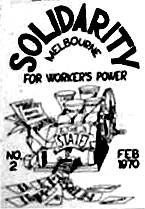Melbourne was the site where the first formal Australian anarchist organisation, the Melbourne Anarchist Club, started on 1st May 1886, publishing this manifesto.
Much is now known about these pioneers of anarchism in Australia, which included: Jack Andrews, David Andrade, Will Andrade, Larry Petrie, Bernard O'Dowd, Monty Miller and many others. Chummy Fleming, in particular, espoused the cause of anarchism in Melbourne until his death in 1950. In 1901 he was part of a small group who protested the opening of the first Australian parliament. He is perhaps best remembered as one of the instigators of May Day celebrations in Melbourne.
See also:
During the first world war, the Industrial Workers of the World were active in Melbourne, with people such as Lesbia Harford.
 After the First World War, the arrival of Italian migrants included a number of anarchists such as Francesco Carmagnola and Isidoro Bertazzon, who played significant roles in the Italian community campaigning against fascism and propagating anarchist ideas. Their efforts included the Matteotti Club, an Italian social centre first located in Spring street, before moving to Victoria street opposite the Victorian Trades Hall. Under the influence of Carmagnola the Matteotti Club developed links with the Trades Hall and the Australian Labour movement. Papers published included Il Risveglio, suppressed by the Commonwealth Government in 1927; La Riscossa, and L'Avanguardia Libertaria both suppressed in 1932 by Commonwealth Authorities.
After the First World War, the arrival of Italian migrants included a number of anarchists such as Francesco Carmagnola and Isidoro Bertazzon, who played significant roles in the Italian community campaigning against fascism and propagating anarchist ideas. Their efforts included the Matteotti Club, an Italian social centre first located in Spring street, before moving to Victoria street opposite the Victorian Trades Hall. Under the influence of Carmagnola the Matteotti Club developed links with the Trades Hall and the Australian Labour movement. Papers published included Il Risveglio, suppressed by the Commonwealth Government in 1927; La Riscossa, and L'Avanguardia Libertaria both suppressed in 1932 by Commonwealth Authorities.
After the Second World War anarchists such as Boris Franteschini and Bruno Vannini were active within the Italian community in Melbourne, particularly during the period 1950 to 1965. Their activism was recognised by the english speaking anarchist movement at the Centenary celebrations in May 1986.
In the 1940's Jim Dawson's publication, Southern Advocate for Workers Councils, developed an international readership, and is now better known in Left Communist circles overseas than here in Australia. During the first world war Jim Dawson had heard wobblies speaking on the Yarra Bank, and had joined an IWW club (The Detroit IWW aligned with the Socialist Labor Party in the USA). For two years he edited the One Big Union Herald for the Workers' International Industrial Union. During the early 1940's he set up the Workers Literature Bureau to counter the flood of stalinist material, mainly with material by the Socialist Party of Great Britain, and the Australian Socialist Party. Dawson moved progressively closer to a council communist position, typified by the publication of Pannekoek's Workers Councils. Dissident marxist, Paul Mattick, put Pannekoek in touch with J.A.Dawson, and Workers Councils was finally serialised in Southern Advocate for Workers Councils in 1948-9. (Refer related links)
 Dawson had some contact with Chummy Flemming, by now an old anarchist. On a front page article in Southern Socialist International Digest 22 (September 1946) titled `Importance of Election', the editor quoted approvingly the words of local anarchist 'Chummy' Fleming concerning the 'voting cattle' ensnared in the 'parliamentary rat-trap'. Dawson also used translations by Melbourne school teacher and anarchist, KJ Kenafick, for his journal. Dawson also had an influence on Richard Curlewis, an advocate for workers control and a member of the Communist Party of Australia, and subsequently the Anarcho-syndicalist Federation and Wobblies in the 1990s.
Dawson had some contact with Chummy Flemming, by now an old anarchist. On a front page article in Southern Socialist International Digest 22 (September 1946) titled `Importance of Election', the editor quoted approvingly the words of local anarchist 'Chummy' Fleming concerning the 'voting cattle' ensnared in the 'parliamentary rat-trap'. Dawson also used translations by Melbourne school teacher and anarchist, KJ Kenafick, for his journal. Dawson also had an influence on Richard Curlewis, an advocate for workers control and a member of the Communist Party of Australia, and subsequently the Anarcho-syndicalist Federation and Wobblies in the 1990s.
The 1950's was a period of little anarchist activity in Melbourne. KJ Kenafick continued writing and corresponding with anarchists around the world. Spanish and Italian anarchist groups met for social purposes and raised money to send back to their comrades overseas. Germaine Greer moved to Sydney in 1959, attracted by the lifestyle and debate in the Sydney Libertarian Push. Anarchist groups did not start reappearing in Melbourne until the mid 1960's, on the university campuses.
"... in 1966 a short-lived libertarian group started at Monash and the group T.R.E.A.S.O.N., in direct contact with Sydney and Brisbane, started at Melbourne. T.R.E.A.S.O.N. (The Revolutionary Emancipists Against State Oppression and Nationalism) which overlapped with the Melbourne University A.B.S.C.H.O.L. and anti-war groups, later developed into the Melbourne Anarchist Group. It defined itself as "open to anarchists, pacifists, and libertarians" and published a list of heroes ranging from Jesus Christ to Emiliano Zapata. In 1970 .... the movement became a communicating network of four groups: Melbourne and La Trobe university Groups, Solidarity magazine and a purely worker group. Independent demonstrations were organised. At May Day demonstrations, migrant groups joined the new youth groups.
 From 1966 to the end of the 1970's anarchists were prominent on the three university campuses in Melbourne, but especially Melbourne University and La Trobe University, publishing Black Rag, the Federation of Australian Anarchists Bulletin (first series) and the Victorian Regional Anarchist Bulletin. During the late 1970's two collection of papers showing the theoretical development of anarchism in Melbourne from 1966 were published as the:
From 1966 to the end of the 1970's anarchists were prominent on the three university campuses in Melbourne, but especially Melbourne University and La Trobe University, publishing Black Rag, the Federation of Australian Anarchists Bulletin (first series) and the Victorian Regional Anarchist Bulletin. During the late 1970's two collection of papers showing the theoretical development of anarchism in Melbourne from 1966 were published as the:
Reference: Carnival Anarchism in Melbourne 1970-1975
 The other major anarchist current in Melbourne was what was loosely termed 'carnival anarchism'. It revolved around the Solidarity (1969-1970?), Assassin and Outlaw magazines. Outlaw magazine was a combination of poetry, color images and short texts on surrealism, buddhism and anarchism. In many ways it prefigured the 925 poetry magazine and the creative energy of Melbourne's street poety scene of the 1970s and later.
Projects included:
The other major anarchist current in Melbourne was what was loosely termed 'carnival anarchism'. It revolved around the Solidarity (1969-1970?), Assassin and Outlaw magazines. Outlaw magazine was a combination of poetry, color images and short texts on surrealism, buddhism and anarchism. In many ways it prefigured the 925 poetry magazine and the creative energy of Melbourne's street poety scene of the 1970s and later.
Projects included:
A little known fact is that anarchists were responsible for starting the first Free Legal Aid Service in Australia at the Collingwood Freestore. Free Medical Advice was also available one day a week.
The Anarchist Black Cross was a third group active in Melbourne involving Spanish emigres and young Australian activists in supporting class war prisoners. Some 40 issues of their journal, Acracia, were produced, initially in Spanish then bilingually. It is one of the few projects to succeed in overcoming generational, language and ethnic barriers.
David Andrade is credited with selling anarchist literature in his newsagency in Brunswick in 1886.
In a news agency at Brunswick and later in Liberty Hall, Russell St. Melbourne the brothers operated the first anarchist book shops in Australia. Here they loaned and sold anarchist publications with their publicity noting that "Socialistic Literature of all kinds (both Communist, Collectivist and Anarchist) are well represented, both in books and pamphlets, and newspapers supplied from all parts of the world".Refer to David Andrade page.Historian, Bruce Scates, comments on Andrades Bookery:
By 1892 the Bookery (now over in Russell Street) boasted several hundred volumes and accommodated every conceivable cure to the social problem. 'Literature upon Socialism . . . Freethought, Spiritualism, Theosophy, Mesmerism, Phrenology, Vegetarianism, Antivivisection, Hydropathy [etc]' awaited the enterprising reader. Like McNamara's in Sydney, Andrade's establishment also contained a library. In the Reading Rooms of Liberty Hall, books and newspapers, light and warmth could be purchased for a penny admission. And like the single taxers' Red Van, a few rooms in Russell Street were put to any number of uses. A coffee shop and restaurant backed onto the library, satisfying the needs of mind as well as body. The restaurant's cuisine was strictly vegetarian, partly because it was cheap but mostly out of principle. Henry Salt's Animal Rights and Vegetarian Cookery by 'A Lady' were likely companions on Andrade's bookshelves. And the Bookery was as close as Melbourne came to a clinic for birth control. Pamphlets by Annie Besant advised readers in contraceptive technique: The Illustrated Marriage Guide and Dr Hollis' treatise on Diseases of the Male Generative Organ refined the pleasures and revealed the dangers of sexuality. Indeed, it could be argued that here the radical Bookery performed its most radical function, promoting the discussion of sexuality in a highly repressive society, dispensing 'French preventative's' and vaginal syringes in the belief that women were entitled to control their own bodies.(Refer related links)The Italian Anarchists in exile in Melbourne in the 1920's and early 1930's, had a number of public outlets (initially in the city, later on outside Trades Hall), that sold Italian Anarchist Literature. The first specific post W.W.II anarchist outlet that sold and produced anarchist literature in Melbourne was the Collingwood Free Store at 42 Smith St. Collingwood. It operated in 1971 and 1972.
During 1974 and 1975 anarchist material was available from Slash Asterisk Printers in Johnston st, Fitzroy. The sacking of the Whitlam Labor Government on November 11, 1975 in a bloodless coup executed by the CIA's man at the helm of the Governor Generalship, Sir John Kerr, caused a certain amount of paranoia, and the press was dismantled and taken 'underground'.
In June 1976 the Jura Literature service was formed in Sydney, leading to the establishment of Jura Books in August 1977. Its Melbourne counterpart was the La Trobe anarchists, who imported books which were sold predominantly at stalls on the La Tobe University campus for a number of years.
An Anarchist Centre that provided access to anarchist literature was opened in Richmond at a disused butchershop at the Corner of Willis and Church St, Richmond in 1977.
In 1980 the Libertarian Workers for a Self-Managed Society opened up the first specific Anarchist Bookshop in Melbourne's history, Chummy Fleming Books. The bookshop was located in Toorak just off Toorak Road, near the corner of Chapel St and Toorak Road. Interestingly Toorak is home to Melbourne's ruling classes. Surprisingly in 1980 the rents in the new Toorak shopping centre, the bookshop was located in, were the cheapest in Melbourne. As the arcade was off the main road, the owners found it difficult to lease the shops. The shop closed in 1982, primarily because of a lack of customers due to its location at the back of an arcade in one of Melbourne's toffiest suburbs.
In August 1982 the Melbourne Anarchist Centre was opened at 215 Victoria Parade, Collingwood. The centre contained a bookshop, a library, a meeting room, and a work room for printing leaflets and silk-screening. 'Club Libertaire' dinner/discussions were held here on a number of occasions. The meeting room was used regularly by anarcho-feminists, the nihilists (anarcho-individualists) and the centre collective, of course. (From Treason No11)
Collective Effort Bookshop opened in 1984, initially based at a shop near the corner of Johnston and Gertrude St, Fitzroy, a year later it moved to premises near the corner of Punt Road and Victoria St, Collingwood. The shop closed down in 1987, after two collective members about to travel overseas decided the shop did not have enough support or people to get involved to keep it open.
No specific Anarchist Bookshop was opened in Melbourne until 1996 when an anarchist Collective opened up Barricade / Information Centre at 115 Sydney Road Brunswick. The Bookshop became a target for NeoNazi groups and had its windows smashed twice in 1996. Barricade Books looked like a real live Barricade for over twelve months, temporary iron sheets were placed over the front windows, but the bookshop continued to function. The shop was fitted with bullet proof glass and the collective that runs Barricades has not looked back since then.
Also active in Melbourne since 1992 is Anarres Books, an anarchist mail order and bookstall collective. This Group also distributes titles in Australia for various overseas anarchist publishers.
Of relevance is the establishment of Grasslands Grocery (1999? - ) at Footscray which has a library and distributes free information, as well as raising thousands of dollars for community and social justice causes.
Reference:
- Anarres Books - www.anarres.org.au
- Barricade Infoshop - www.anarki.net/barricade/
Melbourne Anarchism at the end of the twentieth century
This journey has yet to be written, but here are some stops along the tramride:
- The Split - a Monash Anarchist Perspective (1976)
- Libertarian Socialist Alliance for Self Managed Energy Systems: 1978-1979....Takver
- 925 - working class poetry (1978-1983)....Takver
- 1986 Australian Anarchist Centenary Celebrations Conference
- Anarcho-Feminist Celebrations - 1986 Camp
- The Melbourne Tram Dispute and Lockout of 1990....Dick Curlewis
- 1990 Anarchist Organisation & Strategy Conference (Melbourne)
- March 1998: Direct Action Jamboree, Melbourne....Various
- Anarchist anti-election campaign - 1998
- Protests against World Economic Forum at Melbourne Crown Casino September 11 - 13, 2000....Takver
- No Gods No Masters anarchist & Autonomist conference - April 2001....Takver
- MayDay 2001 and the ghost of Chummy Fleming....Takver
Related Links
- Melbourne Anarchist Archives: Drafts and Documents 1966-1973 provides substantial information on the theoretical development of anarchism in Melbourne for the Melbourne/La Trobe current, as well as current issues and debates at the time including: Conscription, Maoism, Anti-war, support for the NLF, student protest, May Day, Workers' Control, the Moratorium movement, Czechoslovakia, Student action for Education.
- Anarchism in Sydney 1975-1981 places the early 70's Melbourne scene within the context of capital city based groups around Australia.
- There is an account of Dawson by Steve Wright 'Left Communism in Australia : J.A.Dawson and the 'Southern Advocate for Workers Councils'' in Thesis Eleven no. 1 1980 refer: http://kurasje.tripod.com/arkiv/4200f.htm)
- see Bruce Scates essay '"Knowledge is Power":Radical Literary Culture and the Experience of Reading' for the importance of books and pamphlets and radical bookshops for the dissemination of radical ideas in the 1890s.
http://idun.itsc.adfa.edu.au/ASEC/HOBA96_Papers/scates.html
This Page is linked from: http://www.takver.com/history/index.htm
© Takver. All Rights reserved except for nonprofit, union or educational use, please credit source.
Last modified: September 18, 2002